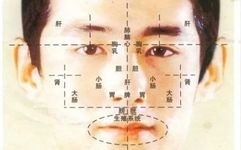Facial Diagnosis in Traditional Chinese Medicine (TCM)
(Abbreviated as Facial Diagnosis)
To know by observation is called “Shen”.

The diagnosis in Traditional Chinese Medicine (TCM) can be summarized in four characters: “Wang, Wen, Wen, Qie” (Observation, Listening, Inquiry, and Palpation). Facial Diagnosis involves observing the characteristics of various parts of the face to identify diseases in the eight major systems of the body, which include: Heart (Brain), Lung (Nose, Throat, Trachea, Bronchi), Liver (Gallbladder), Kidney (Bladder), Spleen (Stomach), Small Intestine, Large Intestine, and Reproductive System.
Generally, the decline of organ function can be observed from the face, even leading to the formation of pathological lesions, judged by aspects such as spots, dots, moles, acne, toxic bumps, wrinkles, etc. The facial complexion can be characterized by colors such as blue, red, yellow, white, and black.

1. The Eight Major Systems
1. Heart (Brain), belonging to the circulatory system, generally reflects on the face as a red color. The task of the circulatory system is to provide oxygen to various tissues of the body and to expel carbon dioxide and waste, supplying nutrients to organs and regulating body temperature. A decline in circulatory function is reflected in two facial areas: the forehead, divided into three parts, with the upper third representing the heart and stress. Stress can arise from busy work, family burdens, or unresolved issues, leading to mental oppression, which may manifest as small acne or discoloration in this area, indicating excessive short-term stress, with symptoms such as irritability, chest tightness, insomnia, and headaches.
The second area is the lowest part of the nose bridge, which reflects the heart. If horizontal grooves, redness, or small blisters appear here, symptoms may include arrhythmia and cardiovascular diseases caused by heart oxygen deficiency: myocardial ischemia, coronary heart disease, and coronary artery sclerosis. A red tip of the tongue also indicates decreased heart function. Additionally, the area between the eyebrows is the brain reflection zone; if this area shows lines resembling a “1”, “II”, or “川” shape, it indicates excessive brain use and poor brain circulation, which over time can lead to headaches, migraines, and memory decline. A depression in this area indicates insufficient blood supply to the brain, directly related to poor heart blood supply, which can lead to brain atrophy or cortical atrophy, causing vascular headaches, migraines, dizziness, trigeminal neuralgia, rapid memory decline, and neck pain or tightness. A “V” shaped line in the brain reflection zone also indicates cardiovascular issues.
2. Lung (Nose, Throat, Trachea, Bronchi), belonging to the respiratory system, reflects on the face as a white color. The specific area is the lower two-thirds of the forehead, which reflects the lungs (upper respiratory tract). If there are acne, toxic bumps, or abnormal colors, it indicates a decline in respiratory function or the presence of disease, suggesting that the patient may have minor issues such as rhinitis. According to the Five Elements theory, the lungs and large intestine are interrelated; sometimes, issues in the organs can reflect on the bowels and vice versa. Some individuals may develop warts in the central forehead area, indicating congenital lung dysfunction.
3. Liver (Gallbladder), belonging to the immune system, reflects on the face as a greenish color. Those who are easily angered can easily harm the liver. There are three reflection points for the liver on the face. The first is the highest point of the nose bridge, where spots, dots, or acne indicate decreased liver function, with bruises indicating severe liver dysfunction. The second area is from the eyebrows outward to the temples, where acne, dark colors, or age spots indicate low liver function; some individuals may experience eye twitching or tearing, which are also related to liver function. The gallbladder area is located on the slopes on either side of the nose bridge; if lumps, moles, or fine lines appear here, it may indicate cholecystitis or gallstones, resulting from poor liver detoxification. Women may develop butterfly spots, melasma, or acne due to hormonal imbalances, which will be explained in detail in the reproductive system section.
4. Kidney (Bladder), belonging to the urinary system, reflects on the face as a black color. The reflective area is on the cheeks, including the ears; the kidneys are the foundation of life, and aging begins with the kidneys. The kidneys govern bones and open to the ears, so symptoms like tinnitus and hearing loss indicate kidney deficiency (referred to as kidney deficiency in men and kidney depletion in women). Seventy percent of deaf children are due to the side effects of injections that directly harm the kidneys; using edible fungi products can gradually restore language and hearing. Black spots on the cheeks or a dark complexion indicate signs of kidney function decline, which can lead to skeletal diseases such as arthritis, bone spurs, rheumatoid arthritis, and osteoporosis. The chin also belongs to the kidney area, where symptoms like lower back pain, weakness, or fatigue can be observed, characterized by small pits or toxic bumps appearing when the mouth is closed with slight force, with the pit’s base being darker than the surrounding skin. This situation may also indicate that women experience soreness and fatigue around their menstrual periods. The bladder reflection point (for both men and women) is at the “Ren Zhong” (Ren-1) point; if acne or blisters appear here, it indicates at least cystitis or urethritis, and in men, it may also indicate prostatitis.
5. Spleen (Stomach), belonging to the digestive system, reflects on the face as a yellow color. The spleen is the foundation of acquired health; TCM states that excessive thinking can lead to stagnation of qi, resulting in poor appetite and blood circulation. The spleen reflects at the tip of the nose; if there are blisters or discoloration, it indicates decreased spleen function, leading to spleen deficiency and dysfunction, which can also affect stomach function. If stomach function declines, all five organs will be affected, as the stomach is the mother of the five organs. The stomach reflection point is at the wings of the nose; if there is abnormal color, acne, or deep discoloration at the base of the nose, it indicates a history of stomach issues for at least 3-5 years. Rosacea further indicates digestive system dysfunction, such as chronic gastritis, gastric acid, bloating, or peptic ulcers, which, if not addressed, can lead to cancer.
6. The small intestine is responsible for absorption. The heart and small intestine are interrelated; if the small intestine does not absorb well, it directly affects the heart, leading to insufficient blood supply to the heart and various heart diseases. The specific reflection point for the small intestine is a small area just below the eyeball; if small acne or spots appear here, it indicates a decline in small intestine absorption function.
7. The large intestine is responsible for excretion. The lungs and large intestine are interrelated; if lung function is poor, qi and blood exchange is inadequate, which over time directly affects the circulatory system, leading to decreased oxygen content in the blood and causing dysfunction in the large intestine, resulting in dry, unformed, or loose stools. The reflection point for the large intestine is at the outer corner of the eyes, extending down from the cheekbone to meet the tip of the nose, forming a U-shape. If spots, acne, or visible blood vessels appear in this area, it may indicate poor intestinal excretion; for women, it may appear as if they have applied blush, indicating intestinal issues. Visible blood vessels can be interpreted in two ways: first, poor liver function, as the liver governs the tendons and nails; second, issues with the large intestine.
8. The reproductive system reflects around the lips. If the corners of the mouth are constantly ulcerated, it may indicate ovarian inflammation or adnexitis. White or yellow spots on the lower lip, differing from normal skin color, indicate excessive leucorrhea; ulcers or peeling around the lips indicate pelvic inflammation; pale lips may indicate anemia or low menstrual flow; overly red or purple lips may indicate heavy menstrual flow or irregular cycles. Cracks and bleeding in the middle of the lips signal decreased reproductive function in both men and women. Some individuals with sexual dysfunction may have difficulty extending their tongues, accompanied by pain, indicating decreased cognitive function. Vertical grooves on the outer upper lip (in women) may indicate premature menopause leading to uterine atrophy.
For women, having an additional organ serves three purposes: (1) reproduction; (2) detoxification. Generally, women tend to live longer than men because they have an additional detoxification organ. Normal menstruation is a form of detoxification, representing youth in women. If a woman experiences menopause in her 30s, she may appear aged; normal menstruation helps prevent illness and maintains normal secretion. If menopause occurs early, toxins cannot be expelled, which burdens the liver, weakening its detoxification function, leading to the appearance of butterfly spots (also known as melanin accumulation), indicating hormonal imbalance. The reflection points for breast health are located between the inner corners of the eyes and the heart reflection points; the appearance of blisters indicates mastitis or hyperplasia, while warts indicate congenital breast (gland) lumps.
2. Three Key Principles
1. Overall color observation; referring to the Five Elements (Red, Yellow, Green, White, Black)
2. Localized positioning; (spots, dots, acne, moles, warts, grooves, wrinkles, toxic bumps)
3. Assessing severity.
3. Three Major Benefits
(1) Self-care;
(2) Attracting new markets;
(3) Better product pairing.
4. Eight Important Considerations
1. Do not speak out what you see; maintain an air of mystery;
2. Do not point out others’ faces; it is disrespectful;
3. Speak with confidence; do not be ambiguous;
4. Do not cover everything;
5. Do not say others are ill;
6. Do not say men have kidney deficiency;
7. Do not stare at others;
8. Do not easily show others.



